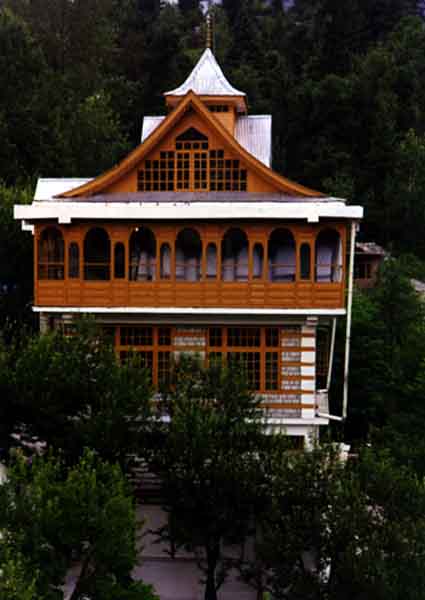
KULLU - MANALI
The Abode of God
Spiritual wisdom lies beneath appreciation of natural beauty all around. Atop Kullu Valley lies the picturesque hill town of Manali hemmed with the silence of mountains, a noise river, calm meadows and beautiful orchards.
Kullu Valley belongs to the Gods and sages and heavenly happenings are 'daily encounters' for the innocent villagers who smile and cry within the ambience of the mystic land. Their 'belief system' is the deep rooted. Every village has its own God and every day is planned by His wish as local MLA and HPCC Chairman Chander Sen Thakur laments!
Some two kilometers away from modern Manali town which was earlier known as Dana Bazar there are two villages, Aleo and Chooga, whose ishtadeva is Brahman named Shristi Nangji. It is a matter of anthropological interest that there is a living medium called 'Gur'. In a state of trance he dictates the 'wish of God'. Roshan, a local village boy narrated that this place is even used to 'vouch' or take the 'oath' of truthfulness. When judiciary is doubted they refer people to take oath before the Gur.
In every village such a story plays a prominent role and enthuse people to live an honest life. This is the contemporary sacredness of Manali. Yet Manali remains mythologically Manualaya or the abode of Manu who remains the seed of living creatures. The story centres around Manu Mandir.
According to mythology Brahma, the creator of the universe, created first Manu and Manu in turn created all the creatures of world. Initially there was water was all around. Manu and his wife were afloat in a boat cruising in search of land. The first land sighted came to be known as Manualaya. It was later accepted as the gate of creation. Today there is a unique new temple called Manu Mandir.
The temple has a monolith stone statue of Vishnu on the left of Manu and on the right is Brahma. The latest addition is Shiva to complete the Trinity of the gods. There is a pyre beneath the temple which is perhaps unparalleled in the temple tradition of India. The story goes that there used to be a demon called Tundi who used to kill human beings. Manu intervened and said the demon could have dead bodies if he desisted from killing living beings. Furthermore Manu promised to worship him as well. Since then 11 logs of wood are kept beneath the temple on a pyre to appease the demon, Tundi. People say some 70-80 years ago people used to burn the deat here as ordered by Manu.
In the month of Magh (January) an eleven day fair called Fhagli is celebrated to appease the demon Tundi. On this day liquor is offered followed by dance and festivity. The Manu temple is also linked to another festival called Chatt festival which celebrates the birth of Manu. It is held after the festival of Diwali which is some time in November this year.
It is interesting to note that the people of Manali go in procession to a village called Goushal every alternate year and people from Goushal come to Manali. In this three day festival Manu Rishi and Mata Hiramba go in a palanquin to Goushal village. The whole village follow them in procession. After a community feast they return to Manali. Similarly, from Goushal, Gautam Rishi, Vyas Rihi and Kanchan Nag are brought in procession to Manali. The festivity of God and Man has been continuing since time immemorial. Through festivity the ecclesiastical spirit lives on and the temple remains the epicentre of spiritual vibration.
A little up the woods is Dhoongri Temple also known as Hidimba Devi Temple. According to hearsay she was a mountain belle rescued from her evil brother by Bhima, one of the Pandav brothers in the epic, Mahabharata. The temple symbolizes the Mother Goddess. Till date animal sacrifice to appease the Mother Goddess is in practice. The temple, made of timber, is unique from the architectural point of view. The pagoda type structure was erected in 1553 AD. It is said the Pandavas spent their period of exile in Kullu. The world famous of Kullu Dussehra is linked with the ceremonial opening or closing of Hidimba Devi Temple.
There are masks and antler horns hung around the temple. The series of wooden carvings of animal motifs are exquisite. One can see a unique symbolism where there is a body of a jumping lion with the face of an elephant. an unparalleled factor in temple motifs and designs.
A little away from old Manali, in the hills amidst nature, is the Vasishtha Temple. Vasishtha was an ascetic who meditated here for a thousand years. He was the Kul Guru of Shree Ram of the Ramayana era and a worshipper of Shakti. He worshipped near the Arjoga river (now known as Beas) during the Satya Yug (Golden Age). It is interesting to know that the sulphur kund (hot spring) sprang up out of Vasishtha's meditation. Desh Raj Sharma whose family has been worshipping Vasishtha for five generations said that this land has remained a seat of meditation for sages. People down the ages come here to get blessed and besmear themselves with mineral water. There is also a small akhara where ascetics gather for a religious discourse. In Manali Gods and sages remain part of the people's ethos.
Dr. Gautam Chatterjee